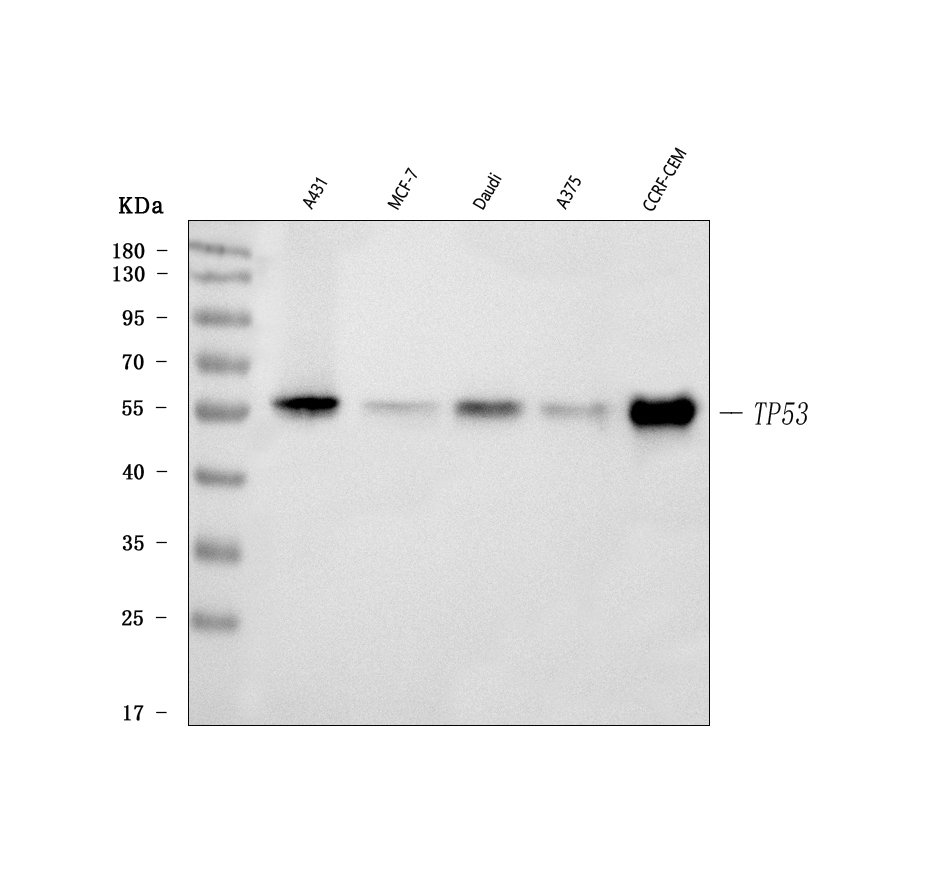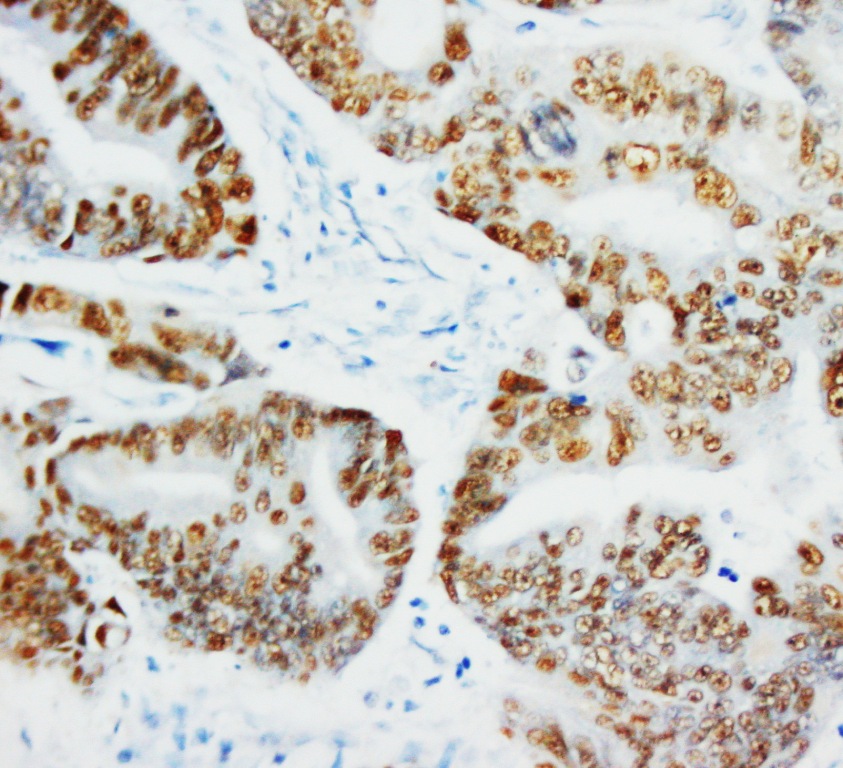| Western blot (WB): | 1:500-2000 |
| Immunohistochemistry (IHC): | 1:50-400 |
| Immunocytochemistry/Immunofluorescence (ICC/IF): | 1:50-400 |
| (Boiling the paraffin sections in 10mM citrate buffer,pH6.0,or PH8.0 EDTA repair liquid for 20 mins is required for the staining of formalin/paraffin sections.) Optimal working dilutions must be determined by end user. | |

Western blot analysis of anti- TP53 antibody (BM0101). The sample well of each lane was loaded with 50ug of sample under reducing conditions.
Lane 1: A431 whole cell lysates,
Lane 2: MCF-7 whole cell lysates,
Lane 3: Daudi whole cell lysates,
Lane 4: A375 whole cell lysates,
Lane 5: CCRF-CEM whole cell lysates.
Use mouse anti- TP53 1:1000, probed with a goat anti-mouse IgG-HRP secondary antibody. The signal is developed using an Enhanced Chemiluminescent detection (ECL) kit (Catalog # EK1002). A specific band was detected for TP53 at approximately 53KD. The expected band size for TP53 is at 53KD.

IHC analysis of p53 using anti-p53 antibody (BM0101).
p53 was detected in paraffin-embedded section of human mammary cancer tissues. Heat mediated antigen retrieval was performed in citrate buffer (pH6, epitope retrieval solution) for 20 mins. The tissue section was blocked with 10% goat serum. The tissue section was then incubated with 1μg/ml mouse anti-p53 Antibody (BM0101) overnight at 4°C. Biotinylated goat anti-mouse IgG was used as secondary antibody and incubated for 30 minutes at 37°C. The tissue section was developed using Strepavidin-Biotin-Complex (SABC)(Catalog # SA1021) with DAB as the chromogen.

ICC/IF analysis of p53 using anti- p53 antibody (BM0101).
p53 was detected in immunocytochemical section of A431 cell. Enzyme antigen retrieval was performed using IHC enzyme antigen retrieval reagent (AR0022) for 15 mins. The cells were blocked with 10% goat serum. And then incubated with 2μg/mL mouse anti- p53 Antibody (BM0101) overnight at 4°C. Fluoro488 Conjugated Goat Anti-Mouse IgG (BA1126) was used as secondary antibody at 1:100 dilution and incubated for 30 minutes at 37°C. The section was counterstained with DAPI. Visualize using a fluorescence microscope and filter sets appropriate for the label used.

Western blot analysis of anti- TP53 antibody (BM0101). The sample well of each lane was loaded with 50ug of sample under reducing conditions.
Lane 1: A431 whole cell lysates,
Lane 2: MCF-7 whole cell lysates,
Lane 3: Daudi whole cell lysates,
Lane 4: A375 whole cell lysates,
Lane 5: CCRF-CEM whole cell lysates.
Use mouse anti- TP53 1:1000, probed with a goat anti-mouse IgG-HRP secondary antibody. The signal is developed using an Enhanced Chemiluminescent detection (ECL) kit (Catalog # EK1002). A specific band was detected for TP53 at approximately 53KD. The expected band size for TP53 is at 53KD.

IHC analysis of p53 using anti-p53 antibody (BM0101).
p53 was detected in paraffin-embedded section of human mammary cancer tissues. Heat mediated antigen retrieval was performed in citrate buffer (pH6, epitope retrieval solution) for 20 mins. The tissue section was blocked with 10% goat serum. The tissue section was then incubated with 1μg/ml mouse anti-p53 Antibody (BM0101) overnight at 4°C. Biotinylated goat anti-mouse IgG was used as secondary antibody and incubated for 30 minutes at 37°C. The tissue section was developed using Strepavidin-Biotin-Complex (SABC)(Catalog # SA1021) with DAB as the chromogen.

ICC/IF analysis of p53 using anti- p53 antibody (BM0101).
p53 was detected in immunocytochemical section of A431 cell. Enzyme antigen retrieval was performed using IHC enzyme antigen retrieval reagent (AR0022) for 15 mins. The cells were blocked with 10% goat serum. And then incubated with 2μg/mL mouse anti- p53 Antibody (BM0101) overnight at 4°C. Fluoro488 Conjugated Goat Anti-Mouse IgG (BA1126) was used as secondary antibody at 1:100 dilution and incubated for 30 minutes at 37°C. The section was counterstained with DAPI. Visualize using a fluorescence microscope and filter sets appropriate for the label used.


